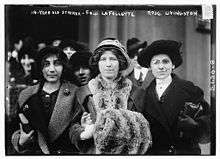Rose Livingston


Rose Livingston (circa 1885-1948), known as the Angel of Chinatown, was a suffragist who worked to free prostitutes and victims of sexual slavery.[1][2][3][4][5][6]
Together with Harriet Burton Laidlaw,[7] Rose Livingston worked in New York City's Chinatown and in other cities to rescue young white and Chinese girls from forced prostitution, and helped pass the Mann Act to make interstate sex trafficking a federal crime.[8] Livingston publicly discussed her past as a prostitute and claimed to have been abducted and developed a drug problem as a sex slave in a Chinese man's home, narrowly escaped and experienced a Christian conversion narrative.[9][10]
Biography
She was born around 1885.
In 1912 while trying to rescue a prostitute she was severely beaten: "serious and permanent damage ... a fracture of the alveolar process of the upper jaw bone which caused severe neurities [sic] with persistent neuralgic pain both day and night ... likewise causing the loss of all the teeth of the upper jaw on one side of the face."[11]
In 1914 she participated in one of the Suffrage Hikes from Manhattan to Albany, New York.[12]
In 1929, she was awarded a gold medal by the National Institute of Social Science.[3]
In 1934 she was found living in poverty, and a retirement fund was established for her.[13]
In 1937 she was awarded a silver cup by Edith Claire Bryce (1880-1960) of the Peace House for her "deeds of courage without violence".[14]
See also
- Somaly Mam, also rescued sex slaves
Footnotes
- ↑ "Suffragists Give Talk In The Park. Miss Rose Livingston and Mrs. Myron Vorce Give Address", Mansfield Shield, 13 October 1914
- ↑ "Finds Mission Work at Home" (PDF), New York Sun, 21 March 1934
- 1 2 "White Slave Racket. Rose Livingston, "Angel of Chinatown," Warns Mothers to Be on Their Guard", Lincoln Star, 29 April 1934
- ↑ "How Rose Livingston Works In Chinatown. Free Lance Missionary's Worst Enemy Is Mayor Gaynor, Metropolitan Temple Audience Hears" (PDF), New York Times, 3 December 1912
- ↑ Ruth Rosen (1983), The Lost Sisterhood: Prostitution in America, 1900-1918, JHU Press, p. 57, ISBN 9780801826658
- ↑ Alan F. Dutka (2014), AsiaTown Cleveland: From Tong Wars to Dim Sum, The History Press, p. 29, ISBN 9781625850867
- ↑ Laidlaw, H. B. (Harriet Burton), b. 1874, Papers, 1851–1958, A Finding Aid, harvard.edu
- ↑ Brian K. Landsberg. Major Acts of Congress. Macmillan Reference USA: The Gale Group, 2004. 251-253. Print
- ↑ Lui, Mary Ting Yi (1 September 2009). "Saving young girls from Chinatown: white slavery and woman suffrage, 1910-1920". Journal of the History of Sexuality.
- ↑ Massotta, Jodie. Decades of Reform: Prostitutes, Feminists, and the War on White Slavery Archived 2014-07-15 at the Wayback Machine.. Diss. University of Vermont, 2013. Print.
- ↑ Mary Ting Yi Lui (1 September 2009), "Saving Young Girls from Chinatown: White Slavery and Woman Suffrage, 1910–1920", Journal of the History of Sexuality, Vol. 18 (3): 393–417, doi:10.1353/sex.0.0069
- ↑ "Fears Gang Will Kill Her. Miss Livingston Says $500 Has Been Offered for Her Death", New York Times, 8 January 1914
- ↑ "Chinatown Angel Found Destitute", United Press in the Berkeley Daily Gazette, 17 August 1934
- ↑ Eugene Kinkead and Harold Wallace Ross (October 2, 1937). "Peace House". New Yorker. Retrieved 2013-12-02.